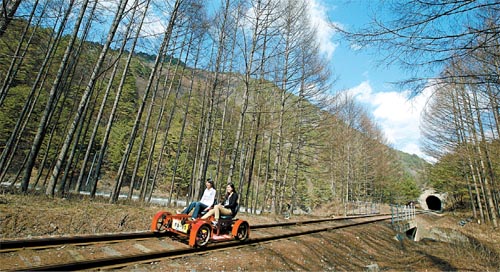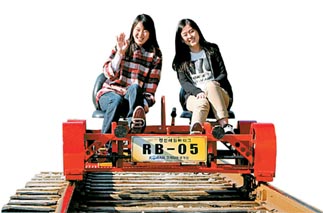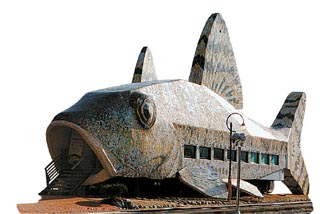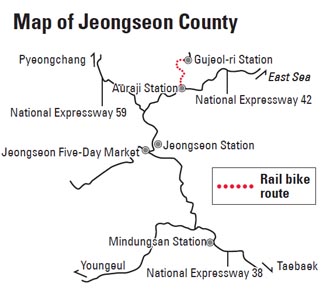Ride the rails on your own steam

The Jeongseon rail bike route wanders through densely wooded areas and long-unused rail tunnels. By Sohn Min-ho
The Jeongseon rail line was once used to transport coal, agricultural and forestry products but was transformed in 2005 for recreational use. It now carries passengers who ride four-wheel pedal bikes with two or four seats down a track that snakes through forests and scenic waterways.
They might not look like much but the rail bikes have been a big hit. The venture has generated a total of 1.1 billion won ($983,400) in profits since it was first introduced five years ago.
In the past, the Jeongseon area boomed with the coal mining business and the railroad was the lifeline of the town’s economy. Commercial activity centered around the Jeongseon rail line, a 7.2-kilometer (4.5-mile) stretch connecting Jeongseon and Gujeol-ri stations. But when the coal mining business started to wane, so did the importance of the Jeongseon line. Korail put an end to the train route on Nov. 14, 2001.
The recreational rail bike service started on June 30, 2005. It was the first successful recreational use of a dormant railroad in the country. The response from visitors was immediate and the income from the service has helped sustain the region amidst the decline of other industries.

A Jeongseon rail bike travels along a railroad that used to transport coal from the mines.
The service begins operating at 9 a.m. and continues at two-hour intervals for a total of five trips a day. During the peak summer season, the hours of operation are extended to include two additional runs at 7 p.m. and 9 p.m. but the service is so popular that it’s often difficult for visitors to find a seat.
“I usually don’t carry my business card around because travel agents always ask me for rail bike tickets. In the summer, people start lining up for tickets at 5 a.m.,” said Park Jong-hae, who is charge of the Korail Tourism Development branch in Jeongseon.
The success of the rail bike service has prompted several other cities to launch their own rail bike enterprises. The cities of Mungyeong, North Gyeongsang, and Gokseong, South Jeolla, have reconfigured their abandoned railways for rail bike services. The city of Samcheok, Gangwon, went so far as to a lay a new railroad along a scenic seaside route so that it could start its own rail bike service.

Auremchi Cafe, located near Auraji station
The rail bike route, the majority of which is downhill, starts from Gujeol-ri Station and continues to Auraji Station. Riders can then take a tourist train from Auraji back to Gujeol-ri, with no extra charge for the train ride.
The downhill ride is comfortable, which is a big reason why Jeongseon is a popular destination in comparison to other rail bike routes. It’s also popular because the track travels deep into a forest that sits 1,322 meters (4,340 feet) above sea level.
The route is safe and does not exceed a slope of 30 degrees, and the bikes are equipped with brakes.
When the ride is over, there is plenty to do in Jeongseon. The Jeongseon Five-Day Market opened for the first time on April 12. It is held on the 2nd, 7th, 12th, 17th, 22nd and 27th of each month. The market is known for the diversity of mountain herbs and vegetables for sale. There is plenty to eat and drink at the market but corn makgeolli, or traditional rice wine with a hint of corn flavor, and buckwheat noodles are the regional specialty.

Auraji and Gujeol-ri stations have cafes with whimsical designs that make them an attraction all their own. In keeping with the spirit of the area, the cafe near Gujeol-ri Station is made of two train cars. The fish-shaped exterior of Aureumchi Cafe near Auraji Station is a colorful addition to the surrounding landscape.
Visitors can reserve tickets for the Jeongseon rail bike by going directly to Gujeol-ri Station or by making a reservation at www.railbike.co.kr. The ticket prices are the same for on-site and online purchases and the cost is 18,000 won ($16.15) for a two-seater and 26,000 won for four-seaters.
By Sohn Min-ho [jason@joongang.co.kr]










with the Korea JoongAng Daily
To write comments, please log in to one of the accounts.
Standards Board Policy (0/250자)